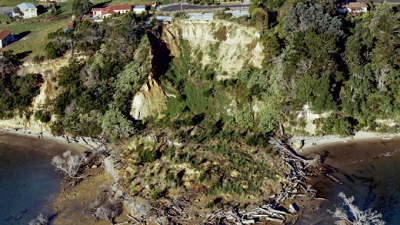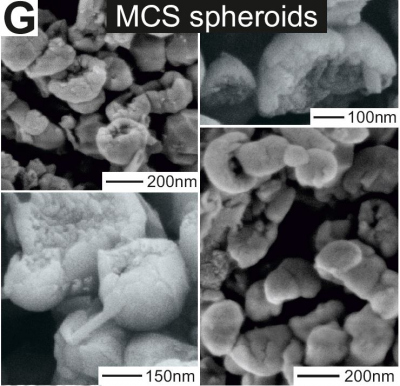Page path:
- Home
- Discover
- Media Releases
- Media Releases 2017
- Tiny particles with a huge impact
Tiny particles with a huge impact
What role do clay minerals and their properties play in areas of frequent landslides? Max Oke Kluger, PhD student in the International Research Training Group INTERCOAST at MARUM – Center for Marine Environmental Sciences at the University of Bremen ‒ along with colleagues, has investigated a flow slide in altered volcanic ash deposits in New Zealand and analyzed its components in the laboratory. One significant result was the discovery of a new kind of structure of the clay mineral called halloysite. This form is probably responsible when such materials behave like a liquid during landslides. The team has published their results in the current issue of the professional journal ‘Geology’.
In many regions of the world, volcanic ash layers cover large areas of the landscape. These ash layers are evidence of volcanic eruptions in the past. Volcanic glass, which is the predominant component of the ash, weathers rapidly, and degrades to start forming clay minerals within thousands of years. In the past, researchers have believed that the clay mineral halloysite plays an important role in slope slides. Its precise role, however, was not known.
Max Kluger and his team, for the first time, have carefully investigated the different halloysite nanocrystalline structures in detail. This kind of material is very abundant there and so entire slopes often slump away. The study was based on a core retrieved from a cliff section on the east coast of New Zealand.
The scientists investigated the following questions: How large was the landslide, how did it impact the environment, and how did the halloysite particles behave in the deposits? “Clay minerals have particular properties,” explains the first author. “Depending on the type of mineral the soil can become mobile, and the deposits slump more quickly and with greater magnitudes.”
The team’s investigations revealed that in soils that are especially susceptible to landslides a particular morphologic structure of halloysite occurs that was previously unknown. The particles are round but have an opening on one side, and under the scanning electron microscope exhibit an appearance similar to mushroom caps. The key discovery: The group realized that the electrostatic charge of the particles determines how stably they are bound to other halloysites. In long chains they are relatively stable, but when fragmented and as individual particles they are more randomly arranged and the material becomes softer and weaker. Where this is the case, the material of a landslide does not simply remain lying at the foot of the slope, but flows farther like a liquid and can thus devastate large areas of land.
“In our opinion, the cause of the landslides is a failure of electrostatic attractions between particles at the nanoscopic level. This mechanism was not previously known,” says Max Kluger. So when the soil is no longer consolidated after a landslide, rain, for example, can further soften the material, possibly leading to a renewed slumping of the soil.
In this study the researchers carefully investigated the layer involved in the landslide. This is a model study, for which the team travelled to New Zealand three times. As a consequence, when the clay mineral can be identified at other locations, these study results could help to alleviate the losses due to slide flows, or perhaps even to prevent them.
The results are primarily important for volcanic areas. “This is where the clay mineral can be formed. The layer we studied consists of volcanic ash deposited from an eruption,” explains Kluger. The silica-rich material with a high content of halloysite occurs, for example, in rainy regions like New Zealand and Japan, but less frequently in dryer areas like Italy. Similar deposits have been studied in Japan. “It would be interesting if our colleagues in Japan were to find similar forms of halloysite as we did and to come to the same conclusions,” says Kluger. Future research work could reveal to what extent parallel conditions and processes occur in Italy.
Because landslides also impact areas on land, human populations also have an interest in the results of Kluger and his colleagues. One consequence could be, for example, that construction on slopes should be reduced compared to that carried out in the past. Kluger’s results are particularly significant for these regions. “When the material can be identified in the soil, this could play a positive role in the prevention of landslides.”
Contact:
Max Oke Kluger
Telephone: 0421-21865841
E-mail: [Bitte aktivieren Sie Javascript]
Original publication:
Max O. Kluger, Vicki G. Moon, Stefan Kreiter, David J. Lowe, G.J. Churchman, Daniel A. Hepp, David Seibel, M. Ehsan Jorat and Tobias Mörz (2017)
A new attraction-detachment model for explaining flow sliding in clay-rich tephras.
Geology, 42(2), 131-134, doi:10.1130/G38560.1
In many regions of the world, volcanic ash layers cover large areas of the landscape. These ash layers are evidence of volcanic eruptions in the past. Volcanic glass, which is the predominant component of the ash, weathers rapidly, and degrades to start forming clay minerals within thousands of years. In the past, researchers have believed that the clay mineral halloysite plays an important role in slope slides. Its precise role, however, was not known.
Max Kluger and his team, for the first time, have carefully investigated the different halloysite nanocrystalline structures in detail. This kind of material is very abundant there and so entire slopes often slump away. The study was based on a core retrieved from a cliff section on the east coast of New Zealand.
The scientists investigated the following questions: How large was the landslide, how did it impact the environment, and how did the halloysite particles behave in the deposits? “Clay minerals have particular properties,” explains the first author. “Depending on the type of mineral the soil can become mobile, and the deposits slump more quickly and with greater magnitudes.”
The team’s investigations revealed that in soils that are especially susceptible to landslides a particular morphologic structure of halloysite occurs that was previously unknown. The particles are round but have an opening on one side, and under the scanning electron microscope exhibit an appearance similar to mushroom caps. The key discovery: The group realized that the electrostatic charge of the particles determines how stably they are bound to other halloysites. In long chains they are relatively stable, but when fragmented and as individual particles they are more randomly arranged and the material becomes softer and weaker. Where this is the case, the material of a landslide does not simply remain lying at the foot of the slope, but flows farther like a liquid and can thus devastate large areas of land.
“In our opinion, the cause of the landslides is a failure of electrostatic attractions between particles at the nanoscopic level. This mechanism was not previously known,” says Max Kluger. So when the soil is no longer consolidated after a landslide, rain, for example, can further soften the material, possibly leading to a renewed slumping of the soil.
In this study the researchers carefully investigated the layer involved in the landslide. This is a model study, for which the team travelled to New Zealand three times. As a consequence, when the clay mineral can be identified at other locations, these study results could help to alleviate the losses due to slide flows, or perhaps even to prevent them.
The results are primarily important for volcanic areas. “This is where the clay mineral can be formed. The layer we studied consists of volcanic ash deposited from an eruption,” explains Kluger. The silica-rich material with a high content of halloysite occurs, for example, in rainy regions like New Zealand and Japan, but less frequently in dryer areas like Italy. Similar deposits have been studied in Japan. “It would be interesting if our colleagues in Japan were to find similar forms of halloysite as we did and to come to the same conclusions,” says Kluger. Future research work could reveal to what extent parallel conditions and processes occur in Italy.
Because landslides also impact areas on land, human populations also have an interest in the results of Kluger and his colleagues. One consequence could be, for example, that construction on slopes should be reduced compared to that carried out in the past. Kluger’s results are particularly significant for these regions. “When the material can be identified in the soil, this could play a positive role in the prevention of landslides.”
Contact:
Max Oke Kluger
Telephone: 0421-21865841
E-mail: [Bitte aktivieren Sie Javascript]
Original publication:
Max O. Kluger, Vicki G. Moon, Stefan Kreiter, David J. Lowe, G.J. Churchman, Daniel A. Hepp, David Seibel, M. Ehsan Jorat and Tobias Mörz (2017)
A new attraction-detachment model for explaining flow sliding in clay-rich tephras.
Geology, 42(2), 131-134, doi:10.1130/G38560.1




